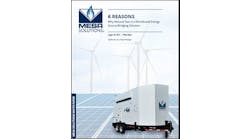California regulators are exploring a range of possible incentives to encourage local energy. Merrian Borgeson of the Natural Resources Defense Council explains.
The California Public Utilities Commission (PUC) unanimously voted yesterday to tackle how to better integrate local energy resources like onsite solar generation and energy efficiency into the state’s energy mix, with the bold goal to “deploy distributed energy resources that provide optimal customer and grid benefits, while enabling California to reach its climate objectives.”
Using what is formally known as a “proceeding,” the commission will explore how to best source – through a range of possible incentives – smaller clean energy resources that connect at the more local level of our energy system. The distributed energy resources (DERs) include energy efficiency (smarter energy use that reduces the amount of energy demand), energy storage, electric vehicles, demand response (customers altering energy use to lower system costs), and distributed renewable generation resources (such as small-scale solar and hydro power).
Despite being smaller and more local resources (as compared to a massive gas power plant or a solar array in the desert, for example) these resources add up – they are growing rapidly and can contribute to meeting our climate goals, as well as improve service reliability and lower costs – if harnessed strategically. This proceeding aims to tap into these resources so that, when possible, they contribute value at the right times and locations to optimize both customer and grid benefits.
While this may seem very technical, it’s good news for getting cleaner energy into our homes and businesses, and reducing pollution from dirty power. And it reflects the reality that how we make and use energy is evolving thanks to clean energy technology.
The decision approved today also makes it clear that this discussion will move forward “in parallel” with the Distribution Resources Plans (DRP) proceeding, another commission forum that is vital to more strategically deploying the distributed energy resources. The purpose of the DRP proceeding is to move the utilities toward a “more full integration of distributed energy resources into their distribution system planning, operations and investment.”
In contrast, the proceeding approved today involves the commission thinking more broadly about the policy framework and incentives needed to encourage a wide portfolio of DERs that can help meet our goals to reduce the pollution fueling climate change. Originally, this proceeding was focused much more narrowly on how to better coordinate traditional utility programs.
The change in focus is the result of multiple workshops and sets of comments, where the commission staff and lead Commissioner Florio listened and responded thoughtfully to a wide range of stakeholders who asked for the commission’s leadership in determining how to best tap into the growing wealth of distributed energy resources in California. This proceeding is timely, much needed, and we look forward to engaging in this leading-edge dialogue that will explore how local energy resources can both offer customers more choices and contribute to addressing climate change.
Merrian Borgeson is an NRDC senior scientist, energy and transportation, San Francisco. This blog originally appeared on Switchboard, the staff blog of the Natural Resources Defense Council.






